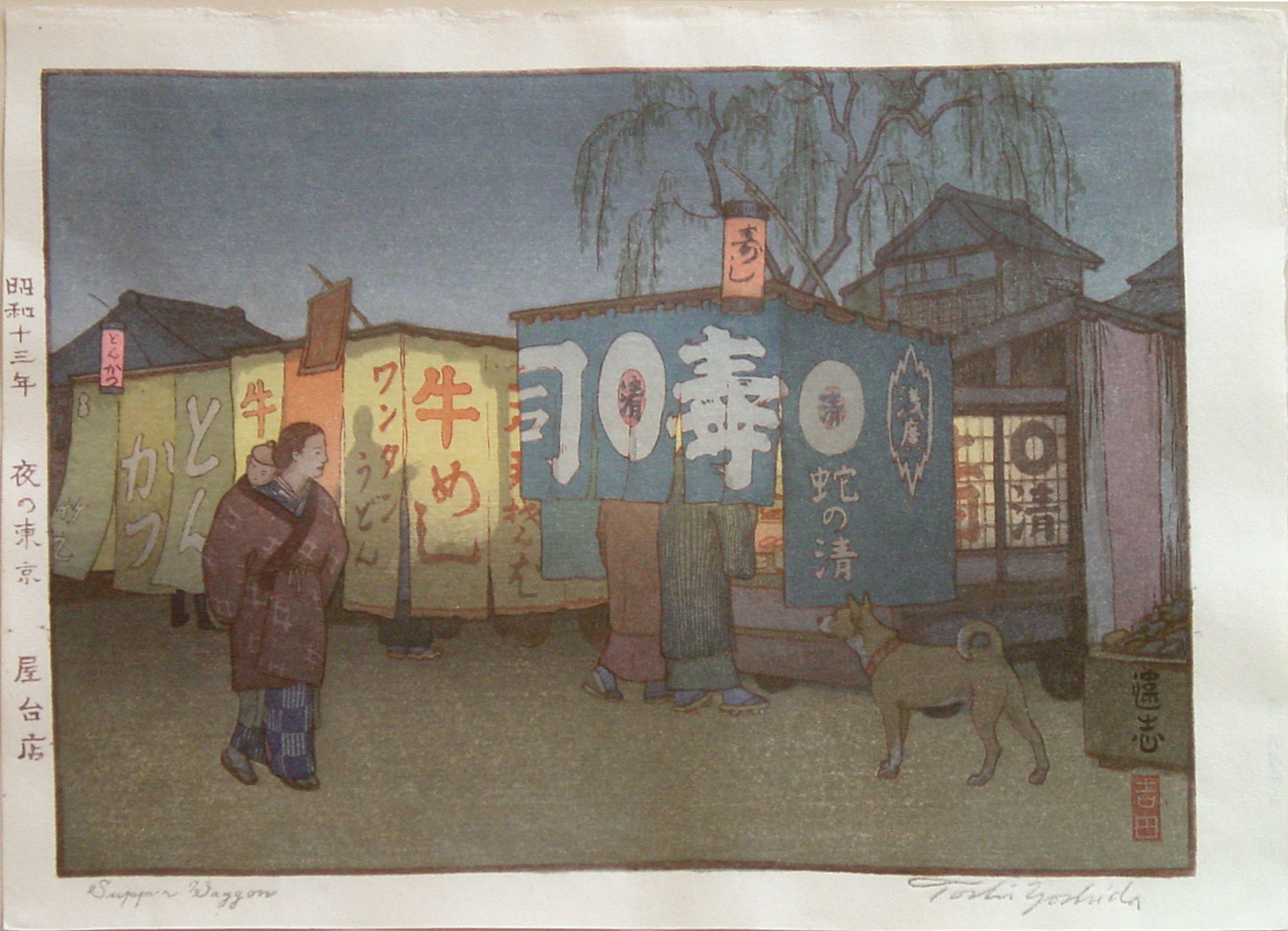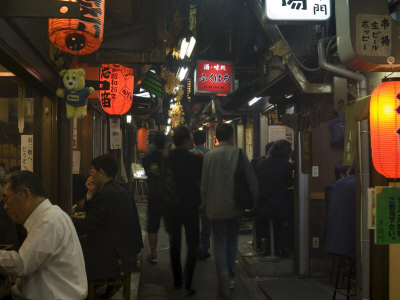About This Print
Source: Shin-Hanga New Prints in Modern Japan, Kendall H. Brown, Los Angeles County Museum of Art 1996The 1938 print Supper Wagon by Yoshida Hiroshi's eldest son, Toshi, brings shin hanga townscapes into their second generation and virtually to the beginning of the Pacific War. This print from Yoshida Toshi’s ten-part Tokyo at Night series, encapsulates many aspects of the entire shin hanga movement. Stylistically the subtle play of cool colors reflects the chromatic studies of Shinsui (1898-1972) adapted from Western art. Similarly, the wonderful rear illumination of the words written on the lanterns and cloth flaps of the food stalls translates effects of oil painting or watercolor into the woodblock print medium. Toshi, who trained cutting and printing blocks with his father, added a slightly grainy quality to suggest the crepuscular light that dissolves the edges of forms as they merge with the night. These effects of light and texture together with subtle contrast between the balanced verticals and horizontals of the food stalls and the fluid forms of the dog, woman, and willow tree, convert the most mundane subjects into objects of great beauty.
But the print is not only beautiful, it is poignant. Shinjuku, an inexpensive entertainment district built at the terminus of several national and suburban rail lines, was a bustling urban area by the late 1930s. By 1928 the Shinjuku station reportedly processed more passengers than Tokyo station. At the time of Toshi’s print Shinjuku boasted several large movie theaters as well as a thriving geisha district, which forced those in Kagurazaka and Yotsuya out of business. For all the crowds and bustle of the real Shinjuku, Toshi presents fully only the images of a woman, her child, and a waiting dog. Hidden behind the flaps of the nighttime stalls advertising wonton with noodles, pork cutlet, fried beef, and other cheap delicacies, we see only the silhouettes and legs of men. In late 1930s Japan, when troops were fighting along the coast of China, the presence of men in ghostly or decapitated forms, the lone woman, and the faithful dog surely had profound connotation. Far from being stylistically or thematically detached from its age, Toshi’s print - and the best of shin hanga - represent the subtle but very real consonance of this popular art with the spirit of Japan in the Taisho and early Show periods.
Source: The Japanese Print Since 1900: Old dreams and New Visions, Lawrence Smith, British Museum Publications Ltd, 1983, p. 106.
This scene is one which even today can be seen in the streets of Tokyo at night. Small booths, covered only by printed cotton curtains, sell bowls of soup or noodles, often at very low prices, to passers-by. Among the foods advertised in this keenly observed print are sushi, udon (fat noodles in soup) and meat dishes. A woman carries her child on her back in the traditional manner. It is difficult to reconcile this scene with a nation mobilizing for an aggressive war.
Modern Shinjuku with its foodstalls
Print Details
| IHL Catalog | #5 |
| Title | Supper Wagon (屋台店 Yataimise) [title on print is "Supper Waggon" (sic)] |
| Series | Tokyo at Night (夜の東京 Yoru no Tokyo) - a ten print series |
| Artist | Yoshida Tōshi (1911-1995) |
| Signature | Toshi Yoshida in English in bottom margin and 遠志 (Toshi) in lower right of image |
| Seal | 吉田 red "Yoshida" seal in lower right of image |
| Publication Date | 1938 original publication date [昭和十三年 as printed in left margin] |
| Edition | Later edition date unknown, but likely after the artist's death and before 2000. Signature is stamped rather than signed in pencil, as are earlier editions. |
| Publisher | Yoshida family studio |
| Printer | |
| Impression | excellent |
| Colors | excellent |
| Condition | excellent- mountedin archival mat and framed |
| Miscellaneous | Printed in left margin "昭和十三年 夜の東京 屋台店" (Shōwa 13, Tokyo at night, Supper wagon) |
| Genre | shin-hanga (new prints) |
| Format | chuban |
| H x W Paper | 7 1/2 x 10 1/2 in. (19.1 x 26.7 cm) |
| H x W Image | 6 5/8 x 9 3/8 in. (16.8 x 23.8 cm) |
| Collections This Print | Ruth and Sherman Lee Institute for Japanese Art 2003.109 (edition unknown); The British Museum 1981,0225,0.3.a (edition unknown); Los Angeles County Museum of Modern Art M.2000.105.103(unspecifiededition); Art Gallery of Greater Victoria 2008.021.005 (unspecified edition) |
| Reference Literature | Shin-Hanga: New Prints inModern Japan, Kendall Brown, Hollis Goodall-Cristante, Los Angeles County Museum of Art, 1996, p. 84, figure 114; The Japanese Print Since 1900: Old dreams and New Visions, Lawrence Smith, British Museum Publications Ltd, 1983, p. 90, pl 84 and p. 106. |



